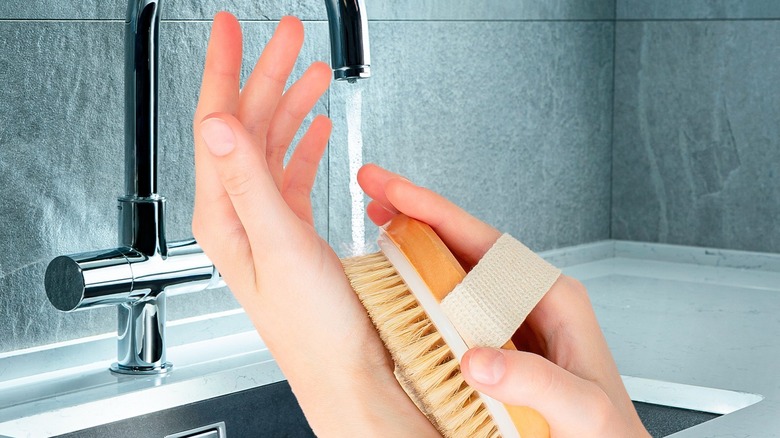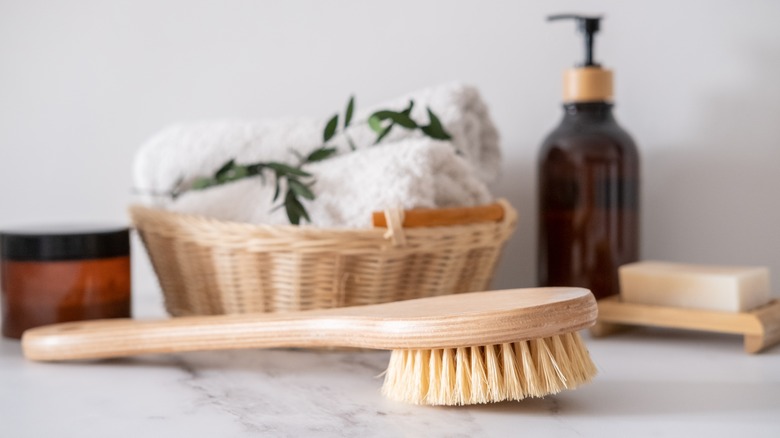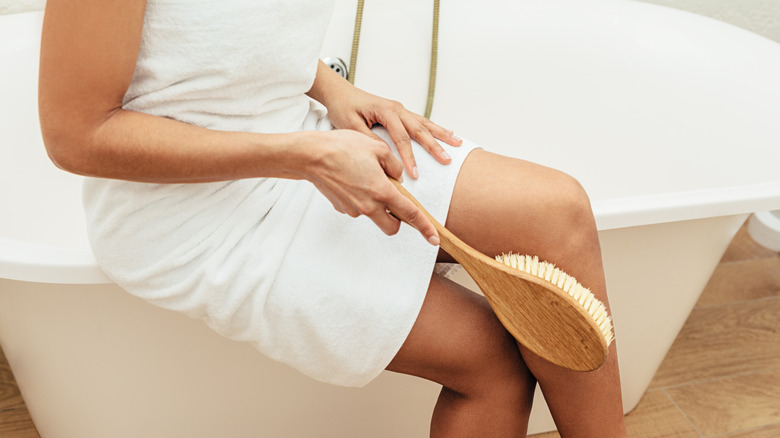Yes, You Should Be Cleaning Your Dry Brush - Here's How
We may receive a commission on purchases made from links.
Sometimes, the list of things we need to regularly clean just keeps piling up. We totally understand the feeling, but when it comes to cleaning your beauty tools, you shouldn't be neglecting them. This goes for makeup brushes, flat irons, hair brushes, and especially your exfoliating dry brush. If you're new to dry brushing, this is an ancient practice that helps to remove dead skin cells and toxins to improve your skin's appearance and circulation. It involves using a dry, soft-bristled brush to rub away dead skin that's been building up.
Though there isn't a lot of scientific evidence to support dry brushing, many people have found it helpful for their skin. Dermatologist Mamina Turegano, MD tells Mind Body Green, "It boosts circulation and stimulates the skin, as you start off at the feet and brush toward your heart ... It's important to acknowledge your skin. It can be very nurturing and healthy." Just as it's important to clean our bodies, it's vital to clean the tools we use to do so. Over time, your dry brush accumulates dead skin and bacteria from repeated usage. If you never clean it, you're just rubbing all that gunk right back into your skin and increasing your risk for infection and irritation. Cleaning your brush will also keep the bristles in good condition so you can get more uses out of it. But what is the right way to ensure you're fully cleaning your dry brush without damaging it?
How to clean your dry brush
There are a few different ways to clean your dry brush. The quickest way is to place the brush under running water, gently rubbing the bristles with antibacterial soap to loosen dead skin and dirt. If your brush has a wooden base, as many dry brushes do, avoid getting the wood too wet, as this can wear down the brush and cause the bristles to fall off.
Another cleaning method is to wash the dry brush in a bowl of warm, soapy water. Only fill the bowl high enough to cover the bristles and not the wood. Place the brush in the water, bristles facing down, and move the brush around in the bowl in order to clean off the dirt. If you have a makeup brush cleaning mat, you can use this to help clean the bristles as well.
After you've washed out the debris as best as you can, let your brush completely dry before using it again. It helps to place the brush on a towel with the bristles facing down to absorb excess moisture away from the wood. Don't share your dry brush with anyone, as this can increase the risk for infections, per Healthline.
How often should you clean your dry brush?
How often you clean your dry brush depends on how often you use it. Some people make dry brushing a part of their daily skincare routine. This typically isn't recommended for those with sensitive skin, but if you like to dry brush every day, you can ideally clean the brush after each use. More realistically, cleaning it every two to three uses will suffice. If you like to space out your dry brushing sessions to once a week or every few weeks, then you can space out your cleaning as well. Experts at Healthline suggest cleaning your brush once a week.
Of course, even with maintenance, your dry brush won't last forever. You'll know it's time to replace your brush when the bristles become worn down and fall out. Also, if you notice any mold or mildew building up on the brush from excess wetness, that'll tell you it's time for a new brush.


